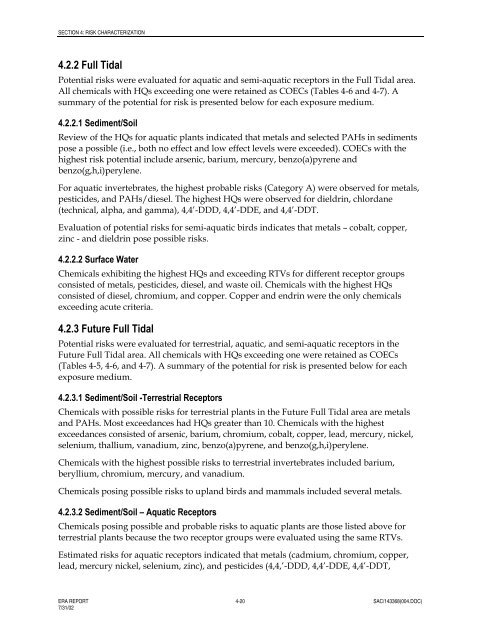1.1 MB pdf - Bolsa Chica Lowlands Restoration Project
1.1 MB pdf - Bolsa Chica Lowlands Restoration Project
1.1 MB pdf - Bolsa Chica Lowlands Restoration Project
You also want an ePaper? Increase the reach of your titles
YUMPU automatically turns print PDFs into web optimized ePapers that Google loves.
SECTION 4: RISK CHARACTERIZATION<br />
4.2.2 Full Tidal<br />
Potential risks were evaluated for aquatic and semi-aquatic receptors in the Full Tidal area.<br />
All chemicals with HQs exceeding one were retained as COECs (Tables 4-6 and 4-7). A<br />
summary of the potential for risk is presented below for each exposure medium.<br />
4.2.2.1 Sediment/Soil<br />
Review of the HQs for aquatic plants indicated that metals and selected PAHs in sediments<br />
pose a possible (i.e., both no effect and low effect levels were exceeded). COECs with the<br />
highest risk potential include arsenic, barium, mercury, benzo(a)pyrene and<br />
benzo(g,h,i)perylene.<br />
For aquatic invertebrates, the highest probable risks (Category A) were observed for metals,<br />
pesticides, and PAHs/diesel. The highest HQs were observed for dieldrin, chlordane<br />
(technical, alpha, and gamma), 4,4’-DDD, 4,4’-DDE, and 4,4’-DDT.<br />
Evaluation of potential risks for semi-aquatic birds indicates that metals – cobalt, copper,<br />
zinc - and dieldrin pose possible risks.<br />
4.2.2.2 Surface Water<br />
Chemicals exhibiting the highest HQs and exceeding RTVs for different receptor groups<br />
consisted of metals, pesticides, diesel, and waste oil. Chemicals with the highest HQs<br />
consisted of diesel, chromium, and copper. Copper and endrin were the only chemicals<br />
exceeding acute criteria.<br />
4.2.3 Future Full Tidal<br />
Potential risks were evaluated for terrestrial, aquatic, and semi-aquatic receptors in the<br />
Future Full Tidal area. All chemicals with HQs exceeding one were retained as COECs<br />
(Tables 4-5, 4-6, and 4-7). A summary of the potential for risk is presented below for each<br />
exposure medium.<br />
4.2.3.1 Sediment/Soil -Terrestrial Receptors<br />
Chemicals with possible risks for terrestrial plants in the Future Full Tidal area are metals<br />
and PAHs. Most exceedances had HQs greater than 10. Chemicals with the highest<br />
exceedances consisted of arsenic, barium, chromium, cobalt, copper, lead, mercury, nickel,<br />
selenium, thallium, vanadium, zinc, benzo(a)pyrene, and benzo(g,h,i)perylene.<br />
Chemicals with the highest possible risks to terrestrial invertebrates included barium,<br />
beryllium, chromium, mercury, and vanadium.<br />
Chemicals posing possible risks to upland birds and mammals included several metals.<br />
4.2.3.2 Sediment/Soil – Aquatic Receptors<br />
Chemicals posing possible and probable risks to aquatic plants are those listed above for<br />
terrestrial plants because the two receptor groups were evaluated using the same RTVs.<br />
Estimated risks for aquatic receptors indicated that metals (cadmium, chromium, copper,<br />
lead, mercury nickel, selenium, zinc), and pesticides (4,4,’-DDD, 4,4’-DDE, 4,4’-DDT,<br />
ERA REPORT 4-20 SAC/143368(004.DOC)<br />
7/31/02






